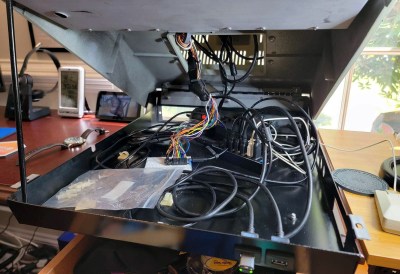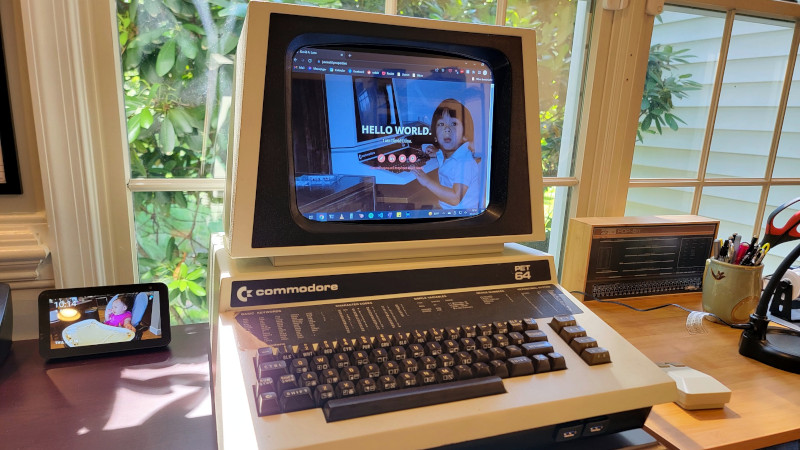There are some projects which once might have been entirely appropriate, but which now seem sacrilegious. [Dave Luna]’s PC docking station in a Commodore Pet 64 case might at first sight seem to be one of them, but there’s a little more to it than gutting a cherished retrocomputer.
 A much younger [Dave] had a dead Pet 64, and because over two decades ago such a thing was considered junk, set about converting it to a PC case. In the way of all ambitious projects it stalled, so here in 2022 he was starting with the metal case and keyboard of a Pet 64 rather than the full computer.
A much younger [Dave] had a dead Pet 64, and because over two decades ago such a thing was considered junk, set about converting it to a PC case. In the way of all ambitious projects it stalled, so here in 2022 he was starting with the metal case and keyboard of a Pet 64 rather than the full computer.
Into the case went a small color TFT monitor, a USB3 hub, a DisplayLink adapter, and and an Arduino Micro doing the job of USB-ifying the Commodore keyboard. The result is a pretty cool docking station, but one which he admits isn’t as nice to use as he’d like. Viewed through rose tinted glasses any PET was an amazing machine in its day, but a slightly lackluster keyboard and a tiny screen don’t quite have the same allure in a world of 4K monitors. Still, we’d have one on our desk.
The Pet appears in quite a few projects that have made it to these pages, for example showing YouTube videos.
















I was hoping this could show a way dock my cat in order to automatically process its egress. I´m deceived. I have to keep my little shovel and gas mask, then :(
Cool! I like the modifications, though the green monitor could have been kept/fixed perhaps.
Without my rose coloured glasses on,
I can’t help but must say that the C64 hardware hardly is rare. It’s the Gameboy (DMG01) of the home computer era.
It was cheap and mass produced. The only precious part was the SID, perhaps. But said SID was prone to damages, also.
Anyway, I mean to say that the chassis, keyboard and the green monitor were the the most rarw parts here. A standard C64 board could be re-installed in that chassis easily any time. Which eaven would give grayscale thanks to functioning colour RAM. So it’s no loss.
The monochrome filter circuit in certain PETs (for providing absolute black/white levels) was perhaps more worth that a C64 Mainboard, too. ;)
I’m an official OldGuy™, I guess. :( “Docking station” to me meant “thing into which you plug the laptop, so that you don’t have to keep plugging and unplugging individual cables.” Still, you had me at ‘Commodore’.
This old man was wondering why someone would want to dock their dog or cat.
Though I do understand the reasoning for docking sheep.
I grew up in the country. Learned things I can’t unlearn.
I advise you stop reading hear until you drink enough to be on verge of blackout drunk.
Did you all know that the infamous ‘boot method’ for ‘docking’ sheep doesn’t work? The geometry is all wrong.
The real method is ‘thigh wader’. Puts your fishing buddies into a new light. Now you’ll always have doubts.
You should now slam that tumbler of vodka. Before this hits long term memory.
I don’t have the words. Just no. I’d as soon as seen an aquarium put in it. The curved corners of the display bezel cutting off the corners of the retrofitted display panel is especially jarring.
As the post says, it was dead when he got it. At least he’s trying to reuse the case to keep it out of a landfill. I absolutely agree that you don’t gut a working or repairable machine. And it’s not a bad combination, a bit of tinkering should be able to fix the screen borders.
I wrote essentially the same, but my reply was lost. The C64 was the gray Gameboy of its day. Cheap. Mass produced. The SID chip was precious too, like was a PET’s green monitor.. The chassis had value, also. Add a bog standard C64 mainboard and it’s more than fixed. It will have colour/grayscale, even. Best wishes, Joshua
I don’t get it either. How hard would it have been to put a C64 in the case?
Perfect for running a PET emulator on
Man oh man, the PET 64 is ultra rare, while the breadbox c64 is super common. This is a rough one.
Just to join all the whining I’d like to see him put an old SVGA monitor in it, the case is just begging for an authentic CRT.
It always weirds me out every time I see an article here about the Commodore Pet. That’s because my first computer as a child was a Commodore Pet… in 1972! Not the same company and certainly not the same machine. Mine was sold as kit from some guy who ran an ad in the back of an electronics magazine of the day. It used an Intel 8008 and the cabinet design was very much like the Imsai and Altair that were to come along later (both of which I also had). The guy only sold about 70 of his kits and most of the buyers I suspect never got them running because the PCB and the documentation was riddled with errors. I only got mine running after several months of reverse engineering and help from my dad (an electrical engineer) and numerous letters, snail mail, back and forth to to the seller/designer.
Where was this? There was the Mark-8 in Radio Electronics for August 1974. And Scelbi had an 8008 computer for a while, kind of out of the mainstream.
We need more details to decide if you’ve garbled or had something obscure.